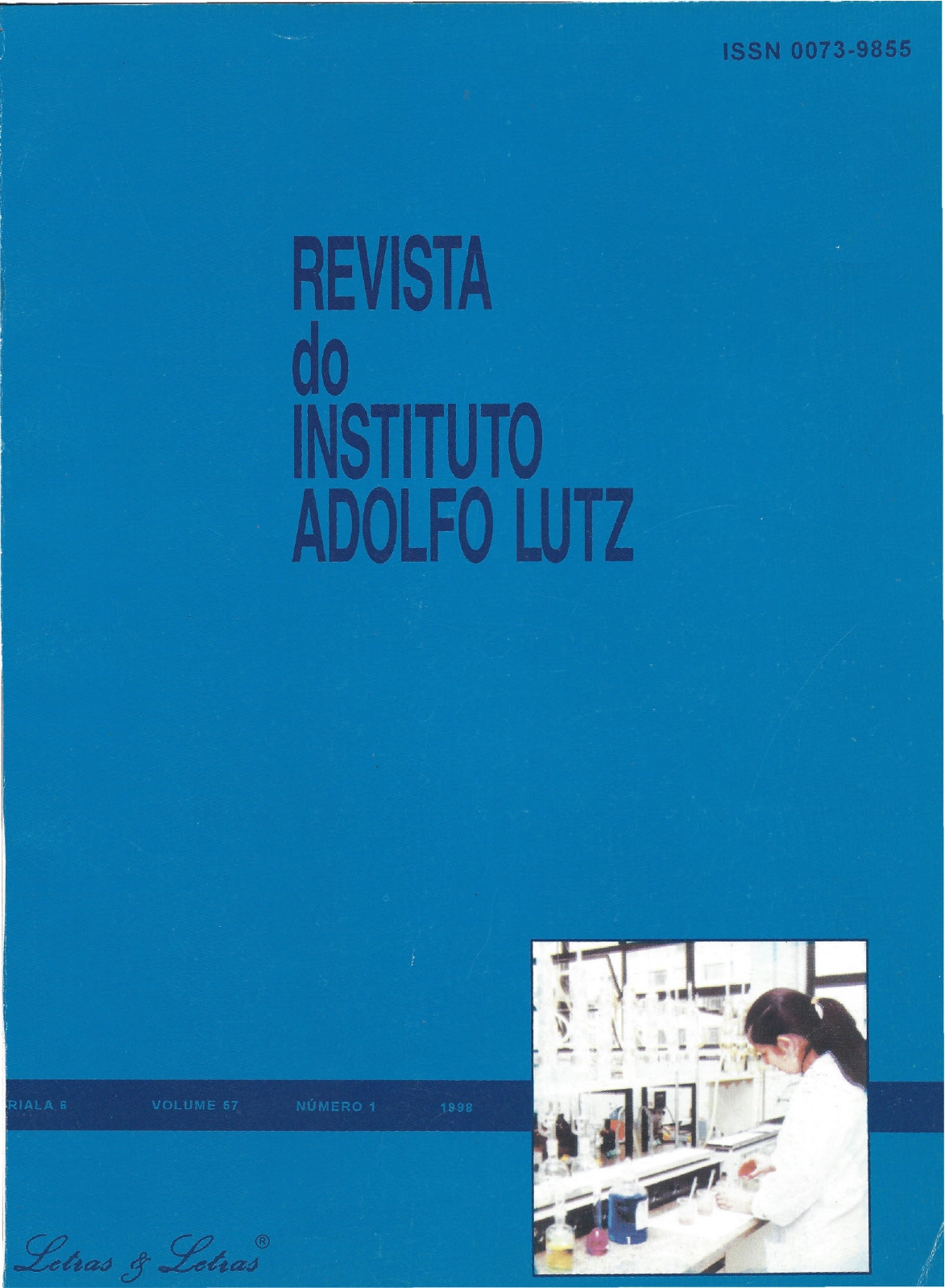Resumo
A diversidade de produtos alimentícios adicionados de vitaminas, inclusive de vitamina A, vem aumentando no Brasil e o controle desses produtos é necessário. Os objetivos desse estudo foram: 1) verificar o teor de vitamina A em alimentos enriquecidos avaliando a concentração em relação ao declarado no rótulo; 2) verificar a variabilidade dos níveis de enriquecimento desse nutriente em diferentes amostras de um mesmo produto; 3) avaliar a quantidade de vitamina A oferecida em uma porção individual de cada alimento em relação à Dose Diária Recomendada (DDR) pelo National Research Council. Foram estudados 20 produtos enriquecidos. A concentração de vitamina A foi determinada em 5 amostras provenientes de lotes diferentes de cada produto, totalizando 100 amostras. Dentre as amostras avaliadas, 45 apresentaram teor de vitamina A na faixa compreendida entre 20% abaixo e 20% acima do declarado no rótulo, 14 amostras apresentaram teor abaixo dessa faixa e 41 acima. A maioria dos produtos apresentou níveis de enriquecimento homogêneo em cinco amostras diferentes. Os alimentos estudados supriam de 18 a 120% das DDR em uma porção única. Sugere-se que a legislação brasileira estabeleça, para alimentos enriquecidos, níveis mínimo e máximo de vitamina A por porção diária habitualmente consumida; que se estenda o beneficio dos alimentos enriquecidos com vitamina A às populações de baixa renda através da adição desse nutriente nos alimentos consumidos pela mesma; que se avalie melhor os alimentos que não podem e aqueles que podem e devem ser enriquecidos.
Referências
2. ARAÚJO, R.L.; ARAÚJO, M.B.G.; SIERO, R.O.;MACHADO, R.P.P. & LAlTE, R.V. Diagnóstico da situação de hipovitaminose A e da anemia nutricionalna população do Vale do Jequitinhonha, Minas Gerais, Brasil. Arch. Latinoam. Nutr., 36(4):642-650,1986.
3. ARROYAVE, G. Nutrificación de alimentos com enfasis en el agregado de micronutrientes a Ia harina de trigo. Arch. Latinoam. Nutr., 43(3):186-190,1993.
4. BLANDIN, A.; DIANCOURT, S.;DUPORT, M.H.; FERRY, M.; GARCIA, 1.; PRUD'HOMME, c., ROCHETTE, M. & SAUNIER, F. Les Aliments "vitaminés" sur le marché. Cah. Nutr. Diét. XXVI (1):87-89, 1991.
5. BRASIL, Leis, Decretos, etc. Resolução 12/78 CNNPA (Comissão Nacional de Normas e Padrões para Alimentos), de 30 de março 78. Diário Oficial, Brasília, 24 de julho de 1978, Seção I - Parte 1.
6. BRUBACHER, G.; MÜLLER-MULOT, W.; SOUTHGATE, D.A.T. Methods forthe determination of vitamins in food: recommended by COST 91.
London, Elscrvier Applied Science Publishers Ltd., 1985. Capo 2, p. 23 - 32: Vitamin A (rctinol and Retinyl Esters) in food : HPLC Mcthod.
7. CANAHUI, E. M.; DARY, O.; DE LEON, L. Retinol stability of fortificd sugar in Guatemala. ln: lntemational Vitamin A Consultative Group Meeting, XVII. Guatemala City, 1996. Report of the XVII Intemational Vitamin A Consultative Group Meeting. USA,OMNI, 1996. P. 130.
8. Codex Alimentarius - Princípios Generales para Ia Adición de Nutrientes Esenciales a los Alimentos, v.4, 1994.
9. DUTRA DE OLIVEIRA, J.E. Fortificação do óleo de soja com vitamina A. Conferência realizada no Workshop sobre fortificação de alimentos. Anfiteatro de Convenções do Campus da USP dia 12/04/94, São Paulo.
10. DUTRAde OLIVEIRA, J.E.; DESAI, I.D.; FÁVARO, R.M.D. and FERRElRA, J.E. Effect ofheat treatment during cooking 011 the biological value of vitarnin A fortified soybean oil in humano Internat. J. Food Sci. Nutr., 45:203-207, 1994.
11. FÁVARO, R. M. D.; SOUZA, N. V; BATISTA, S. M.; FERRIANJ, M. G. G.; DESAI, I. D.; DUTRA DE OLIVEIRA, J. E. Vitamin A status ofpreschool children in Southcm, Brazil. Am. J. Clin. Nutr. 43: 852-858, 1986.
12. FÁVARO, R.M.D.; FERRElRA, J. F.; DESAI, LD., DUTRA de OLNEIRA, J. E. Studies on fortification of refined soybean oil with all-trans retinyl palmitate in Brazil - Stability during cooking and storage. J. Food Comp. AnaI., 4:237-244, 1991. [
13. FÁVARO, R.M.D.; MIYASSAKA, M.S.; DESAI, LD., DUTRA de OLIVEIRA, J. E. Evaluation ofthe effect of heat treatment on thc biological value of vitamin A fortified soybean oil. Nutr. Res., 12:13571363, 1992.
14. FLORES, H. & ARAÚJO, e.R.e. Livcr lcvels of retinol in unselected necropsy specimens: a prcvalence survey of vitamin A deficiency em Recife, Brazil. Am. J. Clin. Nutr., 40:146-152, 1984.
15. FLORES, H.; CAMPOS F. A. e. S; SILVA, M. B. M. & UNS, M. H. e. B. Enriquecimento de alimentos: presente e futuro. BoI. SBCTA, 30 (1):49-55, 1996.
16.FLORES, H.; GUERRA.,N. B.; CAVALCANTr,A.C.A.; CAMPOS, F.A.e.S,; AZEVEDO, M.e.N.A.; SILVA, M.B.M. Bioavailability of vitamin A i.n synthctic rice premix. J. Food Sei., 59:371-372, 1994.
17. GASSIN, A.L. Aspects réglernentaircs de L' enrichissement en France et cn Europe. Cah. Nutr. Diét, XXVI (1):85-87, 1991.
18. H.ALEN, B.; JOHNSSON, H.; MAIMBORG, A von; NYMAN, A. & THORZELL, K. Vitamin A and D supplemented in milk products. Var Fõda , 41 (112): 27-31,1989.
19. OLSON, J. A. Upper limits of vitamin A in infant formulas, with some comments on vitamin K. J. Nutr., 119:1820-1824, 1989.
20. RECOMENDED DIETARY ALLOWANCES. National Research Council. Washington, D,e., 1.974.
21. RECOMENDED DIETARY ALLOWANCES. National Research Concil. Washington, D.e., 1989.
22. RONCADA, M. J.; WILSON, D.; ORANI, E. T.; AMINOS, S. Prevalência da hipovitaminose A em pré-escolares de município de área metropolitana de São Paulo, Brasil. Rev. Saúde Públ., 18:218-224, 1984.
23. SANTOS, L. M. P.; DRICOT, J. M.; ASCIUTI, L. S.; BENIGNA, M. J. C. N.; DRICOT, e. A. Estudo epidemiológico de xeroftalmia no Estado da Paraíba, Rev. Bras. Med., 40, 419-425, 1983.
24. WALTER, P. Vitamin requirements and vitamin cnrichmcnt of foods. Food Chemistry ,49: 113-117, 1994.
25. WATER, P. Quality control of food fortification. Nutriview, A Quartely Update 011 Micronutrients, Nutrition and HeaJth, Bascl, Switzerland, Issue 4, 1995, p. 5.
26. WHO. 1.982. Control of vitamin A deficiency and xcrophthalmia. Techimical Report Scries no. 672.
27. WILSON, D. and SILVA NERY, M.E. Hypovitaminosis A in Rio Grande do Sul, Brazil. Preliminary Study. Internat. J. Vit. Nutr. Res. (suppl. 24): 35-44, 1983.

Este trabalho está licenciado sob uma licença Creative Commons Attribution 4.0 International License.
Copyright (c) 1998 Rosa Maria Duarte Fávaro, Neusa Santesso Garrido, Wilma Delphina de Oliveira Garotti, Cristina Eico Yokosawa, Maria Helena lha, Alceu Afonso Jordão Jr., Hélio Vannucchi
